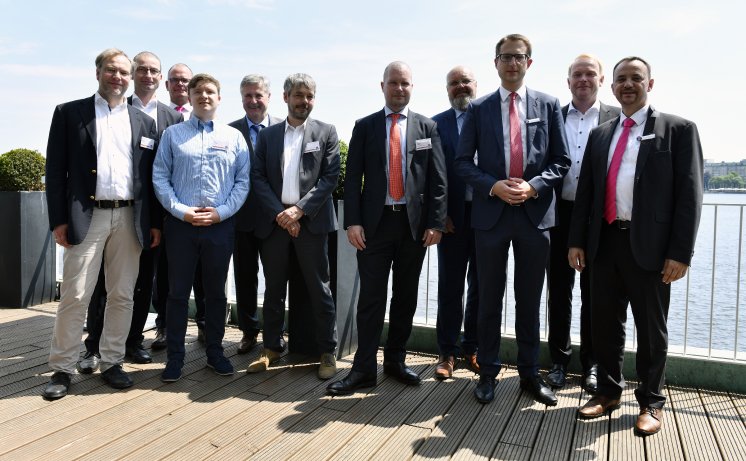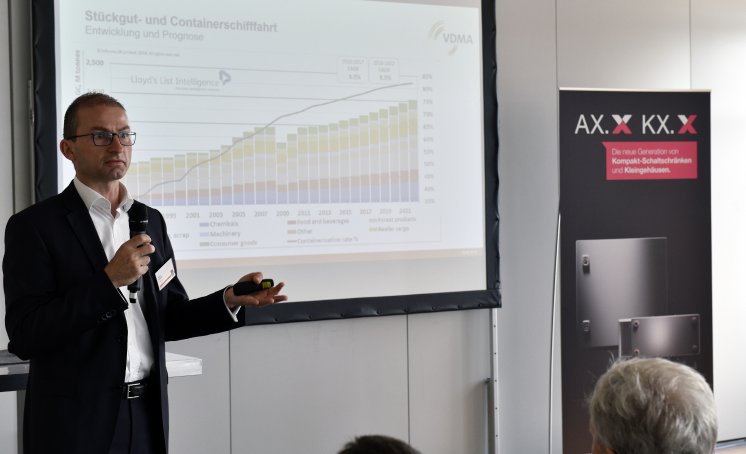Experts from the maritime industry took up the invitation and met in Hamburg for the 10th time in June 2019. They discussed the conference topic of “Smart Propulsion Technologies and their Contribution to Environmental Protection”, relating to how ships will be able to move in an even more economical and environmentally friendly way across the oceans in the future. After all, the volume of world trade is expected to continue rising in the years to come and this will mean that more and more goods will be transported by water.
In their presentations, a number of experts illustrated the way in which the maritime industry was developing. For instance, in his presentation Hauke Schlegel, Managing Director of VDMA Marine Equipment and Systems, showed that more and more goods were being transported worldwide. The total volume is worldwide forecast to be approx. 16 trillion tonnes by 2022. The lion’s share – around 12 trillion tonnes – will be transported as sea cargo. This means that shipping will remain the most important global transport mode for moving goods over long distances. This is why it will also be very important to continue optimising the efficiency and pollutant emissions of marine engines.
Environmental protection and high-tech belong together
After reviewing the global market in shipbuilding, Professor Michael Thoemke from the Maritime Centre at Flensburg University of Applied Sciences showed that environmental protection only works when state-of-the-art technology is used. Future-proof and cost-effective ship operations involve increasing efficiency, cutting costs and environmental protection, as well as providing safety for people and security for the operation of the vessel, as well as data. To solve these challenges, shipbuilding needs high-tech.
Moreover, equipment operators – from the captain to the officers and technical personnel – also have to be relieved. Modern solutions need to independently monitor the reliability of the on-board systems and ensure data security even while data volumes are constantly growing. This requires a system-wide understanding of the development and operation of the ship’s systems. The topics of environmental protection, high-tech components and automation therefore belong together on a ship and are likely to determine how the maritime industry will develop in the future. Generalists who understand the ship system as a whole system are needed here. This will result in new tasks and new specialised roles in shipbuilding.
How will low-emission shipping become reality?
Sönke Diesener, Transport Policy Officer at the German Nature and Biodiversity Conservation Union (NABU), and that body’s shipping expert, referred to another challenge. He draw attention to the emissions of air pollutants from global shipping, pointing out that roughly three percent of global carbon dioxide emissions came from ships. Compared to other means of transport, however, ships were still the better solution, but had to become cleaner. Transferring containers from water to road was not an option in this context.
Synthetic fuels may be the future
Since this marine environmental pollution is predominantly due to the large engines on ships, it is precisely the area where measures to relieve the burden have to be taken. Lex Nijsen, Vice President Sales for four-stroke engine systems at MAN Energy Solutions, which manufactures large engines, showed how solutions for reducing SOx, NOx and CO2 emissions might look. MAN Energy Solutions wants to completely replace fossil fuels and convert synthetic hydrogen (H2) into liquid gas with such recent developments as the MAN “Power To X”. The carbon dioxide footprint would then be close to zero.
Robust measuring technology is needed
Since hydrogen technology does not yet exist, the exhaust gases have to be subjected to after-treatment. This is done, for example, with an exhaust gas scrubber. In addition, the regulations of the International Maritime Organization (IMO) call for the exhaust gas values measured to be logged. If necessary, one can check whether the exhaust gas values have been kept below the valid limits when sailing through an Emission Control Area (ECA). Operators are threatened with high penalties in the event of a violation. Hinrich Brumm, in charge of the measurement technology division at Sick AG, gave a talk on the technologies that are used for exhaust gas measurement in a scrubber system. He explained the requirements and approval processes of Continuous Emission Monitoring Systems (CEMS) in detail. Only when emissions were reliably recorded would operators be able to demonstrate the efficiency of the scrubbers and thus prove compliance with the emission regulations.
Data is driving environmental protection
Many of the new systems and technologies generate a large amount of measured values via sensors. While on the high seas, this data must first be processed and compressed on board before it is sent to a remote data centre for further analysis. That is why modern shipping fleets also need high-performance land-based data centres.
The maritime industry is an important target market for Rittal too, as more and more hardware and software components are becoming part of the on-board infrastructure. Rittal solutions are deployed in numerous shipyards, ships, ports, offshore platforms and inland waterways. Clients include every major ships’ chandlers and shipyards. The solutions offered range from housing and enclosure systems, climate control solutions and to power distribution systems and IT infrastructure solutions.
Following the positive feedback from trade visitors, the next “Ship & Sea” Industry Day has already been planned: Rittal will again be inviting the experts to Hamburg in the spring of 2020. You can find more information on this event at www.rittal.de/schiffundsee.





